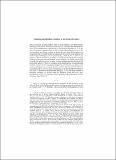Files in this item
Marking innerbiblical allusion in the Book of Ezekiel
Item metadata
| dc.contributor.author | Lyons, Michael A. | |
| dc.date.accessioned | 2018-09-05T14:30:05Z | |
| dc.date.available | 2018-09-05T14:30:05Z | |
| dc.date.issued | 2007 | |
| dc.identifier | 255732575 | |
| dc.identifier | 1a4a04dc-b24a-4fc1-bade-9ecb8400971f | |
| dc.identifier | 61249497740 | |
| dc.identifier.citation | Lyons , M A 2007 , ' Marking innerbiblical allusion in the Book of Ezekiel ' , Biblica , vol. 88 , no. 2 , pp. 245-250 . https://doi.org/10.2143/BIB.88.2.3188998 | en |
| dc.identifier.issn | 2385-2062 | |
| dc.identifier.other | ORCID: /0000-0003-2940-3965/work/60888300 | |
| dc.identifier.uri | https://hdl.handle.net/10023/15970 | |
| dc.description.abstract | How did ancient Israelite authors make it clear that they were purposefully alluding to other texts? After all, the presence of verbal parallels between two texts can be attributed to coincidence, to unconscious dependence, or to the use of formulaic language where words assume a fixed shape because of the social setting and literary genres in which they are used. This paper examines two techniques by which the biblical authors could mark allusions so as to make them more conspicuous and highlight their purposeful nature: inversion of elements, and splitting and redistribution of elements. Examples of these techniques are taken from the book of Ezekiel. | |
| dc.format.extent | 94764 | |
| dc.language.iso | eng | |
| dc.relation.ispartof | Biblica | en |
| dc.subject | BS The Bible | en |
| dc.subject.lcc | BS | en |
| dc.title | Marking innerbiblical allusion in the Book of Ezekiel | en |
| dc.type | Journal article | en |
| dc.contributor.institution | University of St Andrews. School of Divinity | en |
| dc.identifier.doi | https://doi.org/10.2143/BIB.88.2.3188998 | |
| dc.description.status | Peer reviewed | en |
This item appears in the following Collection(s)
Items in the St Andrews Research Repository are protected by copyright, with all rights reserved, unless otherwise indicated.

